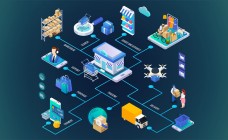Why quick service apparel delivery is the next big thing
By Retail4Growth Team | November 27, 2024
Saurabh Gumber, Founder and CEO at VAMAZA, a Q-Commerce platform for fashion and lifestyle, shares his thoughts on Quick Service is redefining E-Commerce even in the fashion space, in this column.

Wardrobe decisions are often made at the last minute, yet traditional delivery models fail to align with this reality. The demand for ultra-fast delivery services is reshaping how consumers approach online shopping, particularly in the fashion and lifestyle sectors. With delivery time as short as 60 minutes within a 30-kilometer radius, a new level of convenience is now a reality.
Timing Can Make or Break the Shopping Experience
For today’s shoppers, particularly Gen Z, the idea of waiting several days for an order feels outdated. A recent PwC report reveals that 75% of quick-commerce orders are driven by Gen Z consumers, who prioritize immediate solutions and are not deterred by additional delivery costs. Whether it is a last-minute event or a sudden change of plans, having quick access to the right outfit is increasingly viewed as essential.
Fashion is not just a purchase; it is often tied to emotion and occasion. The ability to have clothing delivered on demand adds an extra layer of satisfaction. Unlike other shopping categories, apparel is uniquely time-sensitive. When an outfit is required for a specific moment, speed becomes as critical as quality or style.
Impact of Modern Marketplaces on Consumer Shopping Habits
The rise of ultra-fast delivery has been enabled by modern marketplaces that focus on localized logistics. These marketplaces combine technology and efficient supply chains to offer services tailored to today’s consumer demands. Beyond convenience, they provide customers with a greater sense of control. Features like choosing a delivery time slot and real-time order tracking ensure a smooth and transparent experience.
These platforms are also reshaping how brands operate. For retailers, particularly smaller ones, collaborating with these marketplaces means they can reach customers without the financial burden of maintaining physical stores. By reducing overhead costs and streamlining logistics, businesses can concentrate on creating standout products and reaching a broader audience.
Inclusivity has become another defining feature of these platforms. By offering diverse size options, promoting sustainable practices, and incorporating regional styles, they create spaces that reflect the varied needs of modern shoppers. This shift is not just about selling products; it is about building trust and loyalty through meaningful connections with consumers.
A Win-Win for Brands and Shoppers
For fashion and lifestyle brands, partnerships with quick-delivery platforms are proving to be an effective way to meet growing consumer expectations. These collaborations offer a practical solution to challenges like high rental costs, inventory management, and fluctuating foot traffic in physical stores.
Brands also gain the flexibility to experiment. Limited-edition drops, trend-driven collections, and special promotions can be launched without the logistical complexities of traditional retail. Shoppers benefit by accessing exclusive offerings with the assurance of quick delivery, while businesses can test the market with minimal risk.
Another significant advantage is the ability to reach previously untapped markets. With delivery networks extending into suburban and semi-urban areas, brands can cater to a wider audience without needing to establish a physical presence. This is especially beneficial in a country like India, where digital adoption is growing rapidly across diverse demographics.
India’s Consumer Market is Evolving
India’s retail market is on the verge of a big change. McKinsey estimates that consumption will reach $4 trillion by 2025, thanks to a growing middle class and a younger, tech-savvy population. This makes India one of the fastest-growing consumer markets in the world, with fashion playing a major role in this growth.
As per the study, “E-Styling India: Decoding India's Online Fashion and Lifestyle Shopping Trends”, Fashion alone accounts for nearly 80% of India’s $130 billion lifestyle market, making it a key focus for new e-commerce models. Quick-delivery services are a perfect fit for this shift, offering the speed and personalization that today’s shoppers expect.
Shopping habits are changing fast. It is not just about convenience anymore; consumers want smooth, responsive experiences. Quick delivery helps remove any barriers, making shopping easier and more enjoyable. For brands, this is a chance to stand out and gain a competitive edge in a crowded market.
Meeting the Needs of Modern Shoppers
The appeal of ultra-fast delivery lies in its ability to match the pace of modern life. Whether it is a fashion emergency or a spontaneous shopping decision, being able to receive an order within an hour feels less like a luxury and more like an essential service.
For brands, adapting to this demand is no longer optional. Consumers now expect flexibility, transparency, and reliability. Those who fail to keep up risk losing relevance in a market that is becoming increasingly dynamic. By working with quick-delivery platforms, brands can ensure they stay visible and accessible to their audience.
The growing preference for fast delivery is not a short-lived moment in retail—it reflects a fundamental change in how people approach shopping.
For brands, this is an opportunity to connect with customers on their terms, ensuring that the products they offer are not only desirable but also readily accessible.
The shift toward faster delivery models signals a broader transformation in retail. It’s not just about getting items to customers quickly—it’s about rethinking what the shopping experience can be. For shoppers and brands alike, the possibilities are only growing.


_165_265.jpg)
_165_265.jpg)





Comments